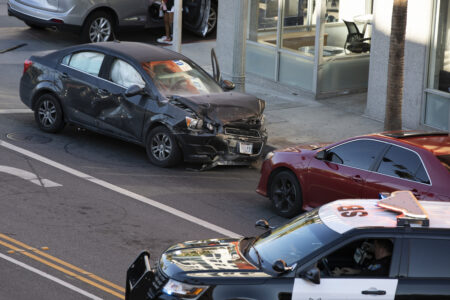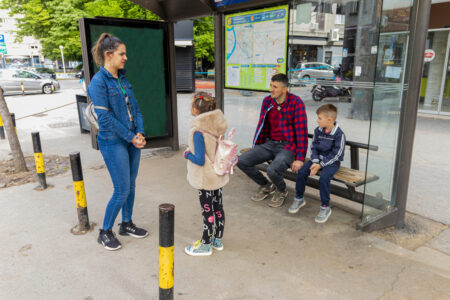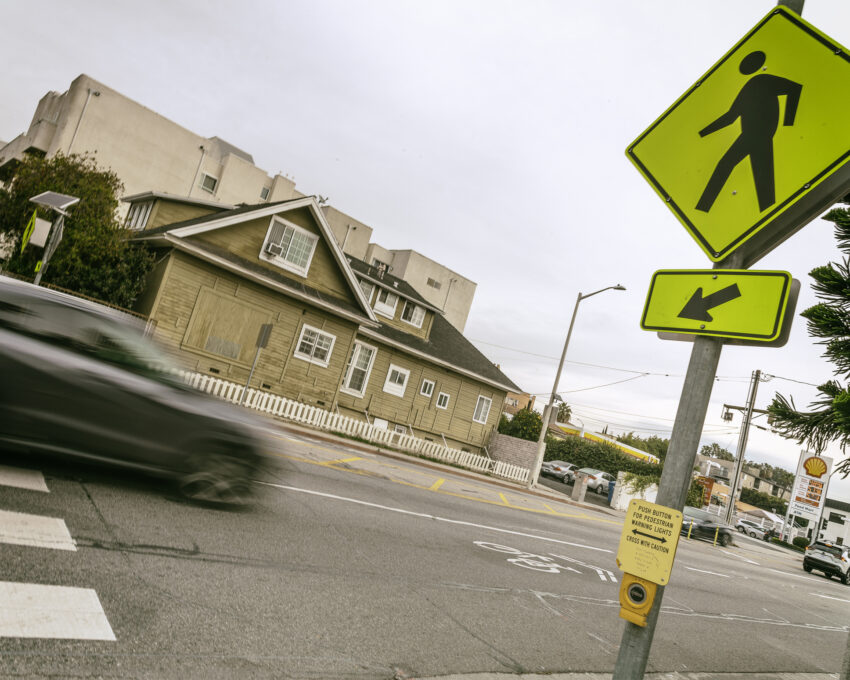
Share On Social!
In December 2023, the Federal Highway Administration (FHWA) released the final rule adopting the nearly 1,200-page 11th Edition of the Manual on Uniform Traffic Control Devices for Streets and Highways (MUTCD).
The MUTCD is the national standard for all road marking, highway signs, and traffic signals.
Three years prior, the FHWA requested public comments on the proposed changes to the then-700-page MUTCD, which hadn’t been updated since 2009.
More than 25,000 people submitted public comments. That included nearly 450 of the model comments developed by our team at Salud America! at UT Health San Antonio.
Let’s explore how the FHWA hit the mark for improvement (or missed an opportunity) for five key areas of concern in our model comments and those of other transportation equity and safety advocates.
Missed Opportunity: Reframe and Rewrite the MUTCD
In their public comments, our Salud America! members and others urged FHWA to reframe and rewrite the MUTCD using a public health and/or Safe Systems Approach, which focuses on creating a built environment where simple mistakes do not result in serious injuries or deaths.
MUTCD was last rewritten 50 years ago from the point of view of expediting vehicle movement. It was full of assumptions, restrictions, and contradictions that hinder efforts to improve safety and create vibrant, welcoming streets.
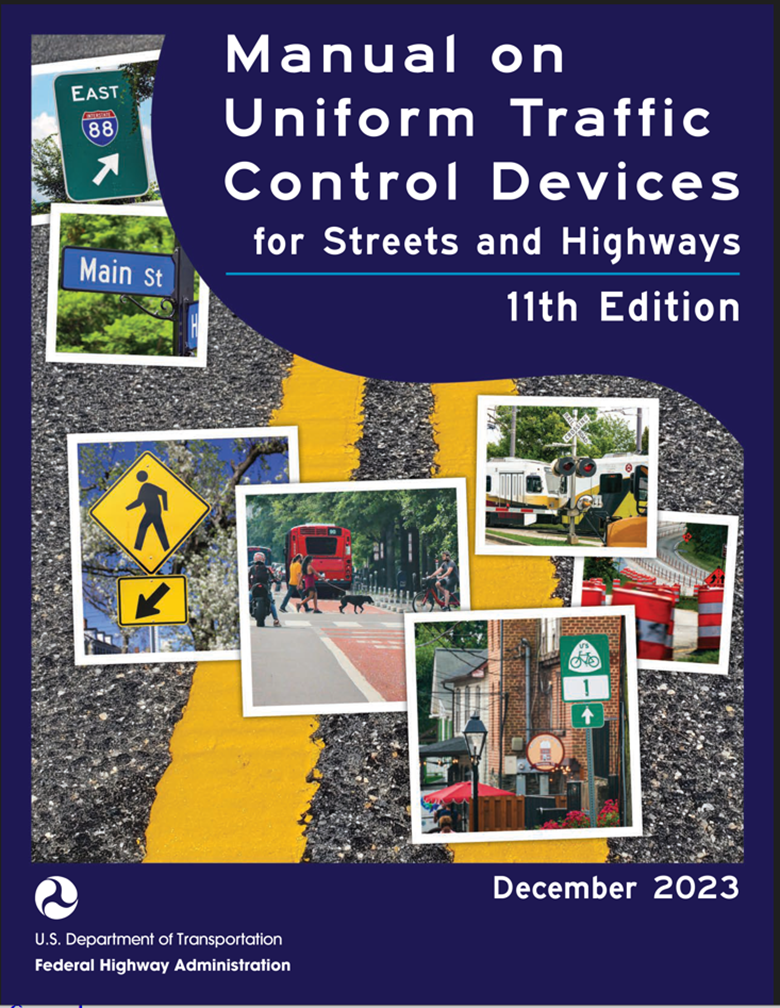 The FHWA did not rewrite or reframe the MUTCD.
The FHWA did not rewrite or reframe the MUTCD.
Thus, they could not have incorporated a comprehensive public health and/or Safe Systems Approach.
Of note, the U.S. Department of Transportation (USDOT) recently adopted a Safe System Approach.
Although the FHWA stated in their summary of the new MUTCD final rule that uniform control devices are part of USDOT’s Safe System Approach, the new MUTCD does not incorporate a Safe System Approach. In fact, the new MUTCD only mentions a safe system approach one time.
For example, the FHWA states the following in their summary of the new MUTCD:
“Uniform traffic control devices are critical to ensuring safety across the roadway network, and are part of the Safe System Approach, adopted by DOT. The Safe System Approach addresses every aspect of reducing crash risks, including safer road users, safer speeds, safer roads, safer vehicles, and safer post-crash care. Traffic control devices influence three of these factors by guiding roadway users toward uniform and predictable behavior; directing roadway users on safe operating speeds; and, in conjunction with roadway infrastructure, separating users in time and space. This approach can prevent crashes and reduce the kinetic energy transfer that can result in human injury or death.”
The only time the new MUTCD mentions a safe system approach is when it states, “jurisdictions can use speed limit setting tools and methods such as expert systems and those consistent with the safe system approach as part of the required engineering study for a non-statutory speed limit,” which leads to our second key area of concern, determining speed limits.
Hit the Mark: De-Emphasize Use of the 85th Percentile Method
In their public comments, our Salud America! members also urged FHWA to de-emphasize use of the 85th percentile method to determine speed limits, which rewards driving at excessive speeds and ignores the presence of people walking and biking.
America Walks, the National Association of City Transportation Officials (NACTO), Toole Design, and other health, safety, and equity advocates echoed this concern.
In the new MUTCD final rule, FHWA de-emphasized the use of the 85th percentile method to determine speed limits. They also emphasized use of contextual factors, such as frequency of access points, land use, public transit volume, pedestrian facilities, bicycle activity, lane widths, geographic context, and crashes.
The updated MUTCD states:
“On urban and suburban arterials, and on rural arterials that serve as main streets through developed areas of communities, the 85th-percentile speed should not be used to set speed limits” without considering contextual factors.
Additionally, the 11th Edition of the MUTCD states:
- “When setting a speed limit, a range of factors such as land-use context, pedestrian and bicyclist activity, crash history, intersection spacing, driveway density, roadway geometry, roadside conditions, roadway functional classification, traffic volume, and observed speeds can influence the speed limit determined in the engineering study. The engineering study will determine which of the recommended factors will prevail in setting the speed limit.”
- “When the 85th-percentile speed is appreciably greater than the posted speed limit, and the roadway context does not support setting a higher speed limit, the engineering study should consider whether changes to geometric features, enforcement, and/or other speed-reduction countermeasures might improve compliance with the posted speed limit. A similar approach should be used if the results of past speed studies indicate that the 85th-percentile speed has consistently increased.”
Missed Opportunity: Address Unrealistic Pedestrian Volume Thresholds for Traffic Control Signals
In their public comments, our Salud America! members and other experts urged FHWA to address the unrealistic volume of unsafe pedestrian crossings to warrant a traffic signal.
In the new MUTCD final rule, FHWA did not adequately address pedestrian-volume thresholds for traffic signal warrant requirements.
According to NACTO, “engineers are still encouraged to wait until several people are hurt or killed before installing a traffic signal.”
In the notice of proposed amendments in December 2020, FHWA proposed to change from “Standard” to “Guidance” the application of the traffic signal warrant criterion considered in an engineering study for installing a new traffic control signal.
This means changing from a required practice to a recommended practice, which would provide flexibility when agencies perform signal warrant analyses.
However, this also means that agencies could continue to refuse to consider a traffic control signal until either a certain volume of pedestrians engage in the risky behavior of crossing a street without a signalized crosswalk or a certain volume of pedestrians are injured or killed while attempting to cross the street without a signalized crosswalk.
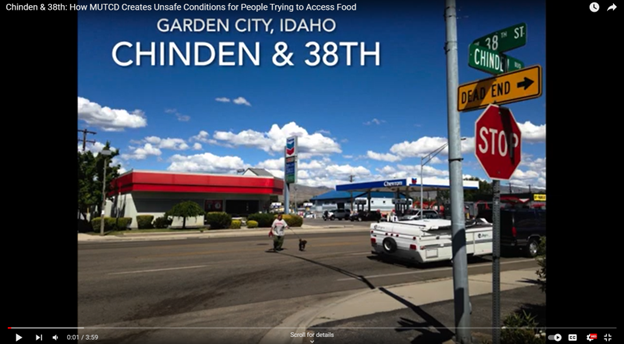 In this video from Kostelec Planning, Don Kostelec uses a street segment in Boise, Idaho, where many neighborhood residents cross midblock to get to a market rather than walk to the signalized crosswalk, a trip which takes 24 minutes round trip, as an example to explain the issue.
In this video from Kostelec Planning, Don Kostelec uses a street segment in Boise, Idaho, where many neighborhood residents cross midblock to get to a market rather than walk to the signalized crosswalk, a trip which takes 24 minutes round trip, as an example to explain the issue.
According to MUTCD’s signal warrant analysis, to justify a pedestrian hybrid beacon, which stops traffic to allow a pedestrian to cross between intersections, at least 20 pedestrians in one hour would need to cross the street midblock.
The city did a signal warrant analysis and found that 18 pedestrians crossed the street midblock in one hour.
What is not considered in this analysis is latent demand, such as people who wanted to quickly walk to the market or nearby greenway trail but chose not to due to either the risky conditions or the time-consuming conditions.
Another aspect of demand that is not considered is people who drive from their neighborhood to the market and back, people who likely would walk if it were not so hostile to pedestrians.
Because the signal warrant analysis was two people shy of the requirement, the agency denied a pedestrian hybrid beacon.
There is concern that per the new MUTCD, agencies would be able to adhere to the volume thresholds in which a high volume of pedestrians must engage in risky behavior before justifying a mid-block crossing.
To this point, in FHWA’s summary about the new MUTCD, they note:
“Warrants are elements of the engineering study along with any other relevant factors. These additional considerations form the basis for conducting an engineering study and the results of the warrants analysis portion of the study is not intended to be the only or the overriding consideration. Agencies can, in fact, install a traffic control signal if a warrant is not met, but they are required to conduct the engineering study that demonstrates that the installation of a signal will improve the overall safety and/or operation of the intersection, which includes documentation of the rationale.”
Beyond the required-versus-recommended concern are additional worries over specific volume thresholds. In response, FHWA explains that research is in progress to update volume thresholds for traffic control signals for both vehicles and pedestrians:
“Additional research is in progress through a National Cooperative Highway Research Program (NCHRP) study examining updates to the vehicular and pedestrian volume thresholds for traffic control signals, pedestrian hybrid beacons, and other pedestrian-actuated warning devices. In addition to pedestrian and vehicular volumes, the research is also examining latent pedestrian demand, land-use, and context to develop additional tools to assist in determining the appropriate traffic control device to improve safety for pedestrians.”
Missed Opportunity: A Section Dedicated to Pedestrians
In their public comments, our Salud America! members and other experts urged FHWA to add a section to the MUTCD dedicated to pedestrians before a section for automated vehicles.
The new MUTCD final rule does not include a section dedicated to pedestrians.
As proposed in December 2020, the MUTCD includes a new section dedicated to traffic control considerations for automated vehicles, but still does not have a section dedicated to pedestrians, despite many comments calling for this addition.
Hit the Mark: More Frequent MUTCD Revisions
In their public comments, our Salud America! members and other experts urged FHWA to develop a plan to update and revise the MUTCD more frequently.
Whether related to public comments or not, the Bipartisan Infrastructure Investment and Jobs Act directed USDOT to update the MUTCD at least every four years.
Before the new MUTCD final rule, the MUTCD had not been updated since 2009.
With the change, that lengthy a gap won’t happen again.
Other Hits, Misses in the MUTCD
In addition to de-emphasis on the 85th percentile rule, the new MUTCD includes other changes that could help save lives, according to Toole Design and NACTO:
- Separated bike lanes and protected intersections
- Standardized signing for two-way separated bike lanes
- Green and red colored pavement markings for bikes and buses
- Rectangular rapid flashing beacons (RRFB)
- Bicycle signal faces
- Two-stage bicycle turn boxes
- Separated crossings for mode-separated shared use paths
- Contraflow bike lanes on one-way streets with parking on both sides
- Changes to the experimentation process
However, regarding red-colored pavement markings, “the manual places unreasonable restrictions on cities and agencies building red transit lanes,” according to NACTO.
NACTO is currently conducting a detailed review of the nearly 1,200-page MUTCD.
Keep an eye out for their findings, which we will also provide here.
Addressing Transportation (and More) in Your Area
You can help shape healthier environments in your city.
Download a Health Equity Report Card from Salud America! at UT Health San Antonio.
The report card provides maps, data, and gauges to compare public health issues, including transportation, to the rest of your state and nation.
You can email your report card to local leaders to stimulate community change.
You can also use the data in your materials or share on social media to raise awareness about local barriers to health equity, where everyone has a fair, just opportunity to be their healthiest.
GET YOUR HEALTH EQUITY REPORT CARD!
Explore More:
Transportation & MobilityBy The Numbers
27
percent
of Latinos rely on public transit (compared to 14% of whites).

